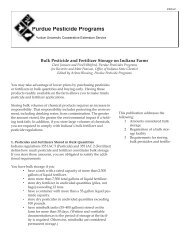Pesticides and Risk Communication PPP-52 - Purdue Pesticide ...
Pesticides and Risk Communication PPP-52 - Purdue Pesticide ...
Pesticides and Risk Communication PPP-52 - Purdue Pesticide ...
You also want an ePaper? Increase the reach of your titles
YUMPU automatically turns print PDFs into web optimized ePapers that Google loves.
Myth 4: We should not go public until we have solutions to the<br />
problems. There may be some logic in the notion that problems are<br />
better accepted when coupled with solutions; but, when you get right<br />
down to it, the public wants a say in their own destiny. They want to be<br />
apprised of the negatives as well as the positives. They want the<br />
chance to voice their own opinions. And sometimes they propose<br />
solutions that the experts have not considered!<br />
Myth 5. These issues are too difficult for the public to underst<strong>and</strong>.<br />
Issues can be complex. Nevertheless, citizen groups throughout the<br />
country have demonstrated that lay people are quite capable of grasping<br />
difficult concepts associated with complex, scientific issues. We<br />
cannot communicate successfully by talking down to the public: they<br />
become justifiably angry.<br />
Myth 6: Technical decisions should be left with technical people.<br />
Technical personnel may be well versed, scientifically; but policy is<br />
determined not only on the basis of science but also public values. And<br />
an informed public is more likely to reach a sound decision than one<br />
that is not.<br />
Myth 7: <strong>Risk</strong> communication is not my job. True, you probably were<br />
hired on the basis of other credentials, but you still have a responsibility<br />
to deal with people. Failure to communicate may result in policy that<br />
damages good science.<br />
Myth 8. Interest groups are responsible for stirring up public<br />
concerns. Activists work to bring about change. They do not create the<br />
concerns; they merely arouse <strong>and</strong> channel attention to those that<br />
already exist.<br />
<strong>Risk</strong> <strong>Communication</strong> in Practice<br />
Our radio <strong>and</strong> television programs are interrupted with the following<br />
weather update: A tornado watch is in effect. Conditions are right for a<br />
tornado to occur in our area within the next fifteen minutes. Prepare to<br />
take shelter immediately.<br />
So, why don’t we? Why do fifty percent of us ignore the alert? Why<br />
do we normal, perfectly sane people—scientists included—dismiss or<br />
totally ignore this kind of information? Why don’t we take shelter?<br />
Why do we ignore safety advisories on the use of seat belts, helmets,<br />
<strong>and</strong> chemical resistant gloves? Why do we ignore our doctors’<br />
advice to lose weight for the sake of our health? The list is endless.<br />
The mystery as to why risk messages have little or no impact is one<br />
of the many puzzles facing social scientists today. And it is even more<br />
36




